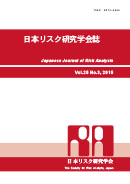Volume 25, Issue 3
Displaying 1-8 of 8 articles from this issue
- |<
- <
- 1
- >
- >|
Editorial
-
2015 Volume 25 Issue 3 Pages 117-120
Published: December 25, 2015
Released on J-STAGE: December 28, 2015
Download PDF (462K)
Papers
-
2015 Volume 25 Issue 3 Pages 121-130
Published: December 25, 2015
Released on J-STAGE: December 28, 2015
Download PDF (535K) -
2015 Volume 25 Issue 3 Pages 131-138
Published: December 25, 2015
Released on J-STAGE: December 28, 2015
Download PDF (803K)
Review
-
2015 Volume 25 Issue 3 Pages 139-144
Published: December 25, 2015
Released on J-STAGE: December 28, 2015
Download PDF (527K)
SRA-Japan the 28th Symposium
Reviews
-
2015 Volume 25 Issue 3 Pages 145-150
Published: December 25, 2015
Released on J-STAGE: December 28, 2015
Download PDF (357K) -
2015 Volume 25 Issue 3 Pages 151-154
Published: December 25, 2015
Released on J-STAGE: December 28, 2015
Download PDF (344K)
Book Review
-
2015 Volume 25 Issue 3 Pages 155-156
Published: December 25, 2015
Released on J-STAGE: December 28, 2015
Download PDF (270K)
Errata
-
2015 Volume 25 Issue 3 Pages 157
Published: December 25, 2015
Released on J-STAGE: December 28, 2015
Download PDF (166K)
- |<
- <
- 1
- >
- >|
